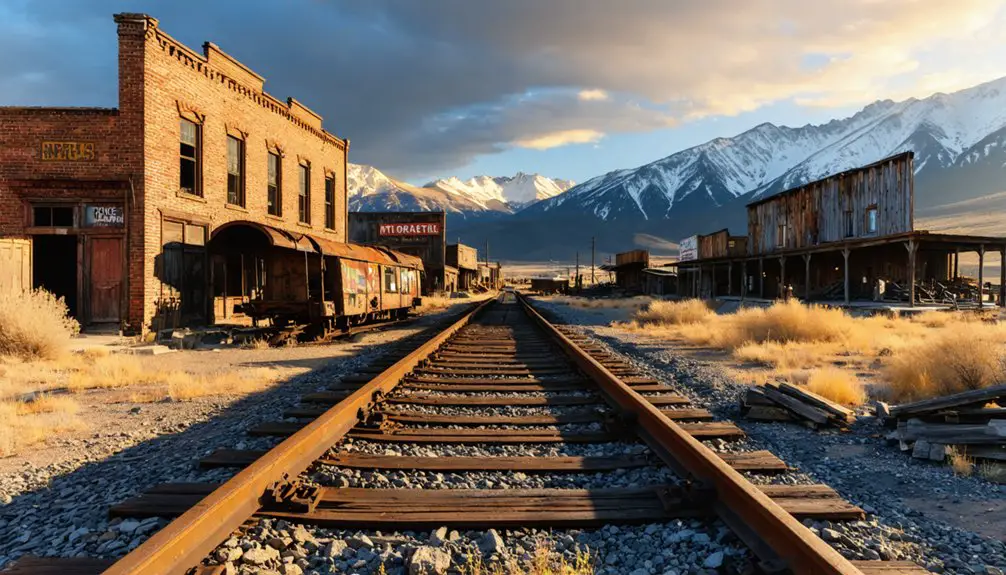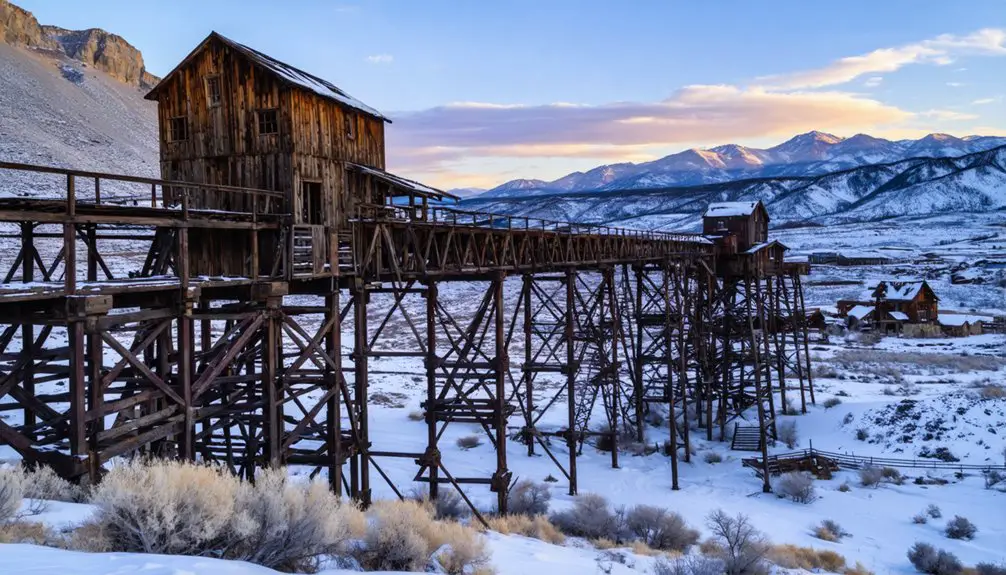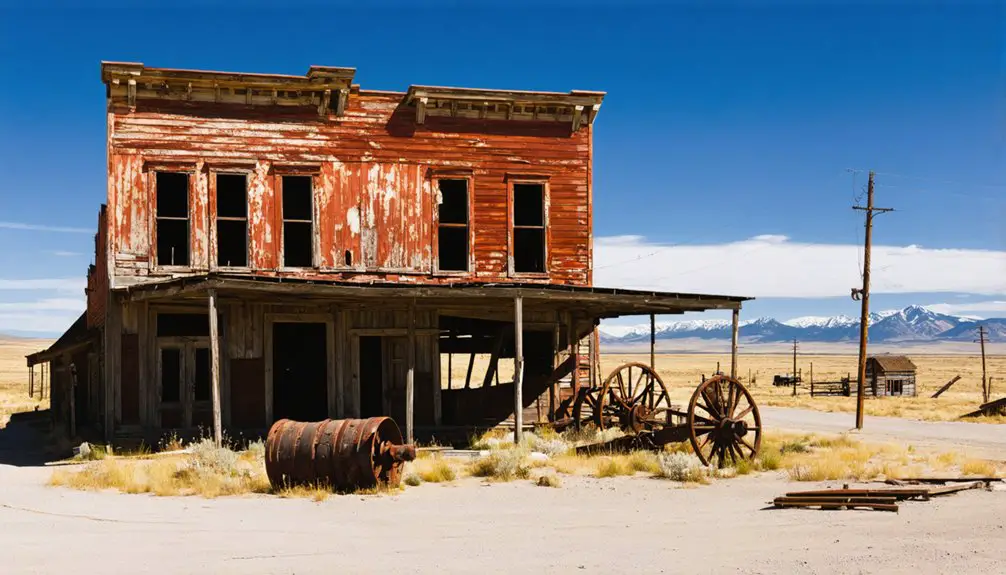You’ll find Dillon nestled in Wyoming’s Carbon County, where it emerged as a rebellious mining settlement in the early 1900s. The town flourished by defying neighboring companies’ strict policies, becoming home to miners working the Ferris-Haggarty copper mine. Its world-record 16-mile aerial tramway transported massive amounts of ore until financial troubles in 1907 led to abandonment. Today, Dillon’s ruins tell tales of frontier life, engineering marvels, and the American West’s untamed spirit.
Key Takeaways
- Dillon was established in the late 1800s as a mining town near the Ferris-Haggarty copper mine in Wyoming.
- The town peaked with 200 residents and 14 saloons, serving as a refuge for miners from neighboring company towns.
- The world’s longest aerial tramway (16 miles) connected Dillon to the copper mine, transporting up to 1,000 tons daily.
- Financial troubles and fraud in 1907 led to Dillon’s economic collapse and eventual abandonment as a ghost town.
- Today, Dillon’s ruins and historical sites attract tourists, with preservation efforts managed by the Grand Encampment Museum.
The Birth of a Rebel Mining Town
While prohibition swept through the company mining town of Rudefeha in 1902, defiant saloon owners established a new settlement called Dillon just a mile away.
You’ll find that these entrepreneurs weren’t simply relocating – they were creating a deliberate haven for miners seeking refuge from restrictive company policies.
The town’s rebel identity emerged from its very foundation, as saloon culture quickly became the cornerstone of daily life.
Dillon’s rapid growth reflected the strong demand among copper miners from the nearby Ferris-Haggarty operation who sought entertainment and social connection.
Within months, it had become the district’s largest settlement, drawing workers who’d been pushed out by Rudefeha’s strict regulations.
This defiant spirit made Dillon more than just another mining town – it was a symbol of resistance against corporate control.
A post office operated in the bustling town from 1902 until its closure in 1909.
The town gained notoriety for its unusual two-story outhouse built to accommodate the heavy winter snowfall.
Life on the Edge: A Town for the Outcasts
This rough-and-tumble town became a magnet for society’s outcasts, drawing miners and drifters seeking refuge from Rudefeha’s strict rules.
You’d find yourself among single men living in roofless cabins, embracing a transient lifestyle far from society’s watchful eye. The outlaw culture thrived in Dillon’s 14 saloons, where pool games and card playing offered escape from the harsh mining life. Located near the Sierra Madre mountains, the town provided easy access for miners working the nearby claims.
Restless souls found refuge in Dillon’s saloons, where outcasts could briefly escape their hardscrabble existence through games and drink.
Daily existence meant maneuvering through deteriorating infrastructure and dealing with extreme weather – even the outhouses had to be built two stories high to handle deep snow. The town emerged after saloons were banned in neighboring Rudefeha.
The town’s reputation for rowdiness required keeping the jail next to a saloon, though formal institutions were scarce.
When mines closed or fortunes changed, these marginalized workers simply disappeared into Wyoming’s vast frontier, leaving Dillon to fade into ghost town history.
Mining Operations and Economic Prosperity

The daily copper mining operations around Dillon centered on the Ferris-Haggarty mine, which you’d find connected to a state-of-the-art aerial tramway system spanning 16 miles to Encampment’s smelter.
You’ll recognize this tramway as a marvel of early 20th-century engineering, being the world’s longest when completed in 1902.
The mine generated an impressive over $2 million in copper ore during its peak operations.
While the North American Copper Company’s ambitious infrastructure promised great prosperity, the mining operations ultimately collapsed amid financial troubles, transforming Dillon from a bustling mining town into an abandoned outpost by the 1930s.
Daily Ore Processing Operations
During Dillon’s peak mining years, ore processing operations centered around the Ferris-Haggarty mine, discovered in 1897, with additional output from the Rudefeha and Rambler mines.
Ed Haggarty and partners initially staked the successful mining claim that would shape the region’s future.
You’d find workers managing multiple shifts to maintain continuous ore extraction and processing at the smelters in nearby Encampment.
The daily ore transportation initially relied on mule teams until the installation of a 16-mile aerial tramway in 1902 revolutionized the process.
This technological advancement notably increased efficiency, allowing for greater volumes of copper ore to reach the smelters.
Workforce management became essential as the operations required coordinated efforts from miners, handlers, and smelter workers.
They’d brave harsh conditions in the Sierra Madre mountain range to keep the processing operations running smoothly, ensuring Dillon’s economic vitality through steady mineral production.
Aerial Tramway Transport System
Revolutionizing ore transport in 1902, Dillon’s Ferris-Haggarty aerial tramway stretched an unprecedented 16 miles across the Sierra Madre mountains, earning its place as the world’s longest mining tramway system.
This aerial innovation transformed copper mining operations, replacing slow wagon transport with an efficient network of 370 towers and three transfer stations. You’d witness nearly 1,000 steel buckets moving continuously at 4 miles per hour, carrying up to 1,000 tons of ore daily. The system’s longest span reached 2,270 feet between towers. Each bucket transported 700 pounds of copper during the four-hour journey.
- Transport efficiency increased from 250 to 350 tons per 24-hour period
- Operating costs dropped dramatically from $14 per ton with wagons
- Year-round operation became possible, unlike weather-restricted wagon routes
- The direct 17-mile tramway route replaced the winding 26-mile wagon path
The tramway’s steam-powered operation, supplemented by water power and gravity, sparked unprecedented economic growth in Dillon and Encampment.
Financial Fraud and Collapse
Despite its industrial achievements, Dillon’s prosperity crumbled in 1907 when investigations revealed widespread financial fraud within its mining operations.
The mining company’s financial deception included selling fraudulent stock and falsely claiming capital far beyond their actual assets, leading to devastating investor betrayal.
The fallout was swift and severe. You’ll find that when financial support dried up, the mines couldn’t sustain operations.
Workers abandoned their homes and shops, leaving behind rusted machinery and roofless cabins. The collapse forced residents to scatter across Wyoming and the western United States in search of new opportunities.
What was once a bustling mining town processing 500 tons of ore daily became another Wyoming ghost town, with only foundations and ruins remaining as proof of its brief but dramatic history. Like the Grand Encampment copper mines, this collapse highlighted the boom-and-bust nature of Wyoming’s mining enterprises.
The Great Aerial Tramway Legacy

You’ll find that Dillon’s aerial tramway, completed in 1902, stood as the world’s longest for six years and revolutionized copper ore transport with its 16-mile system of towers and buckets.
The tramway’s daily operations moved up to 1,000 tons of ore between the Ferris-Haggarty mine and Encampment smelter, reducing transport costs from $14 per ton by wagon to a fraction of that amount. The system was powered by wood-fired steam engines that kept the transport cable moving steadily.
While the tramway’s glory days ended with the mine’s closure in 1908, its remaining towers near Encampment serve as evidence to this remarkable feat of early 20th-century engineering.
Engineering Marvel of 1902
The 1902 completion of the Ferris-Haggarty Aerial Tramway marked an extraordinary feat of early 20th-century engineering in Wyoming’s mining history.
You’ll find this engineering marvel stretched an impressive 16 miles across rugged terrain, establishing itself as the world’s longest aerial tramway at the time. The system’s historical significance revolutionized copper ore transport, replacing slow wagon routes with an efficient aerial solution.
- 270-375 towers supported cables reaching heights of 900 feet
- 840 buckets transported up to 1,000 tons of ore daily at 4 mph
- Hydropower from the South Fork of Encampment River drove the system
- Three transfer stations enabled continuous operation across challenging elevations
The tramway’s innovative design conquered Wyoming’s mountainous landscape, crossing elevations up to 10,690 feet and spanning 2,270 feet over Cow Creek Cańón.
Daily Operations and Impact
Operating at peak efficiency, this remarkable aerial tramway system transformed copper ore transport through a meticulously coordinated daily operation.
You’d find 840 buckets moving continuously along the 16-mile route, each carrying 700 pounds of copper through the rugged Sierra Madre mountains to the Riverside smelter.
The mining logistics relied on three strategically placed cable stations and 370 towers to keep the operation running smoothly.
You could see miners occasionally hitching rides in the ore buckets, while the system moved steadily at 4 miles per hour.
This copper transportation marvel helped establish Dillon as the district’s largest settlement, creating a thriving hub of economic activity.
When the tramway finally ceased operations, you’d witness Dillon’s gradual transformation into the ghost town it’s today.
Final Days and Legacy
When financial pressures and dwindling ore supplies forced the Ferris-Haggarty mine to close in 1908, Dillon’s impressive aerial tramway system ground to a halt, marking the end of an extraordinary chapter in Wyoming’s mining history.
The final days of the tramway coincided with the economic decline of nearby mining towns like Battle, Elwood, and Rambler.
You’ll find the legacy of this engineering marvel preserved at the Grand Encampment Museum, where towers and buckets stand as evidence to early industrial innovation.
- The tramway’s 16-mile length remained unmatched globally during its operation
- Its influence shaped mining transport methods across similar rugged terrains
- The system’s remains now serve as essential educational and tourist attractions
- The preservation efforts keep Wyoming’s copper mining heritage alive for future generations
Daily Life in Dillon’s Heyday
During its peak years in the late 1890s, life in Dillon centered around its bustling saloons and the daily rhythms of copper mining.
You’d find nearly 200 residents, many of whom worked at the nearby Ferris-Haggarty mine, gathering in the town’s drinking establishments after their shifts. The saloon culture thrived precisely because these venues were banned in neighboring company towns.
After exhausting shifts at Ferris-Haggarty, miners flocked to Dillon’s saloons – their only refuge from dry company towns nearby.
Living in one of the 38 buildings that made up Dillon, you’d rely on local stores for supplies and the hotel for visiting guests.
Mining camaraderie flourished as workers bonded over drinks and shared stories. The town’s economy pulsed with activity from the impressive 16-mile aerial tramway, which transported up to 500 tons of copper ore daily to Grand Encampment’s smelter.
The Collapse and Abandonment
The collapse of Dillon began with a devastating 1907 snowstorm that triggered a deadly avalanche, killing three residents and damaging essential infrastructure.
You would’ve witnessed rapid economic decline as nearby mines shut down, especially the Ferris-Haggarty copper mine. Community isolation intensified when harsh winters blocked supply routes, forcing mail carriers to deliver on snowshoes.
The North American Copper Company’s ban on saloons transformed Dillon into a troubled drinking haven, fracturing social bonds.
- Roads deteriorated into footpaths while buildings crumbled, leaving only rusted artifacts
- Mining operations ceased, prompting mass worker exodus to other western territories
- The town’s post office closed in 1909, marking severe population decline
- By the end, only four residents remained to greet a visiting bishop in a dilapidated saloon
Natural Surroundings and Geography
Nestled within Wyoming’s rugged Sierra Madre Mountains, Dillon’s ghost town stands amid the sprawling Medicine Bow National Forest at a high elevation characterized by mixed conifer forests and rocky outcrops.
You’ll find this remote site surrounded by dense stands of pine, fir, and spruce trees that define the area’s natural beauty. Mountain streams weave through the landscape, fed by seasonal snowmelt and precipitation.
The rugged terrain experiences dramatic seasonal changes, from mild summers perfect for exploring to harsh, long winters typical of high-altitude environments.
You’ll need a four-wheel-drive vehicle to navigate the challenging mountain roads that access the site. The surrounding wilderness offers opportunities for hiking, photography, and ghost town exploration while providing essential habitats for local wildlife within the Medicine Bow ecosystem.
Preserved Remnants and Historical Artifacts
While exploring Dillon’s ghost town today, you’ll discover an impressive collection of preserved mining artifacts and structural remains that tell the story of its industrial past.
The Ferris-Haggarty copper mine, which operated from 1897 until 1907, left behind tools and mining debris that showcase the area’s rich mining heritage. You’ll find remnants of the world’s longest aerial tramway that once transported ore, alongside deteriorating log cabins and commercial buildings that paint a picture of frontier life.
Rusted mining tools and crumbling tramway remains stand as silent witnesses to Dillon’s once-bustling copper mining heyday.
- The Grand Encampment Museum preserves relocated structures from Dillon, including homes and saloons
- Archaeological finds reveal 16,000 years of human activity in the region
- Original mining equipment and household items illustrate daily life during the boom years
- The 1960s U.S. Steel open-pit mine represents a later chapter in artifact preservation
Planning Your Ghost Town Adventure
Planning a visit to Dillon requires careful preparation and timing to make the most of your ghost town exploration.
You’ll want to schedule your adventure during summer months when weather conditions are most favorable for outdoor exploration. Since you’ll encounter rugged terrain, a 4WD vehicle is essential for accessing the site.
Your visitor preparation should include GPS navigation tools, detailed maps, and ample supplies of food and water, as you won’t find services at the site.
Pack emergency gear and weather-appropriate clothing, as mountain conditions can change rapidly.
While exploring, you can combine your visit with trips to nearby Rudefeha and Battle ghost towns.
For historical context, stop at the Grand Encampment Museum before heading to the site to understand the area’s rich mining heritage.
Frequently Asked Questions
Are There Any Reported Ghost Sightings or Paranormal Activities in Dillon?
Where there’s smoke, there’s fire – but not here. You won’t find any documented ghostly encounters or paranormal investigations in Dillon. Historical records and local sources show no supernatural activity in this mining ghost town.
What Happened to the Families Who Lived in Dillon After Abandonment?
You’ll find family legacies scattered across Wyoming and the American West, as residents moved independently to find new jobs. Most relocation stories show families dispersing to nearby mining towns or industrial areas.
Were There Any Notable Crimes or Shootouts in Dillon’s Saloons?
You’ll find reports of saloon brawls are largely unconfirmed, though crime legends suggest sheepherders shot up local establishments. Historical records don’t document specific shootouts, but regional violence was common.
Did Any Famous Outlaws or Historical Figures Visit Dillon?
While outlaw legends abound throughout Wyoming’s wild frontier, you won’t find any documented historical visits from famous outlaws to Dillon. The town’s small size made it an unlikely destination.
How Many People Lived in Dillon During Its Peak Population?
You’ll find that Dillon’s demographics peaked at around 200 residents during the late 1890s, when the local economy thrived from copper mining operations at the nearby Ferris-Haggarty mine.
References
- http://www.wyomingtalesandtrails.com/rudafeha2.html
- https://www.wyominghistoryday.org/theme-topics/collections/items/miners-exchange-g-baker-saloon-dillon-wyoming-1904
- https://www.wyomingcarboncounty.com/blog/123-5-ghost-towns-to-explore
- https://www.rv.com/archive/wyomings-spook-route/
- https://www.ghosttowns.com/states/wy/dillon.html
- https://westernmininghistory.com/towns/wyoming/dillon/
- https://wyomingwhispers.com/dillon-wyoming-ghost-town/
- https://www.youtube.com/watch?v=pEBL3LOhEL8
- https://pubs.usgs.gov/bul/0711b/report.pdf
- https://www.donnacoulson.com/?p=820



